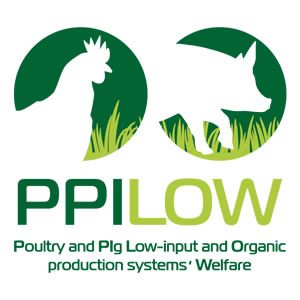Adapting the rearing of dual-purpose breeds in PPILOW experiments in times of avian influenza! – by H. Pluschke (Thuenen) with contributions Thuenen, INRAE, AU, ITAB and SYSAAF

Net-covered outdoor runs at the INRAE research facility in France that currently house the PPILOW cockerels – © Karine Germain, INRAE
Danish and German experiments compare both males and females of dual-purpose crossbreeds to local breeds and currently-used genotypes of layers and broilers, and males are also evaluated in France. These experiments are part of PPILOW strategies of Work package 5 aiming at proposing alternatives to the killing of day-old layer male chicks. However, since October 2020, regional outbreaks and cases of the highly pathogenic avian influenza (HPAI) have been reported in various European countries. The spread of the avian influenza is closely connected to the routes of migratory birds. As a consequence, various precautionary measures, often referred to as a stamping-out strategy, have been put in place to reduce the spread of the virus. Commercial poultry production may contribute to the spreading of the virus, therefore local outbreaks are often followed by preventive culling of the whole flock. Hence it is important to carefully implement precautionary measures to reduce the risk of this harsh method. One of the measures has been the prevention of cross-contamination with wild birds as they might be carriers of the virus. For this, outdoor runs are required to be completely covered to avoid contact to secretions and faeces of wild birds on the pasture. Feeding troughs and drinkers can only be set up in the barn/pen. In some regions, the transport of live poultry across municipalities is not permitted without a negative blood sample. This causes difficulties regarding slaughter scheduling. The ban of the global export of poultry meat from areas with higher infection rates has been implemented as a biosecurity measure. The European regulation for organic production requires that meat-type poultry have access to pasture for 1/3 of their lifetime which can be limited under current circumstances. For organic farms, access to pasture is one of the requirements of the rearing system. Hence with these limited circumstances, it is essential to find ways to provide an environment that can both meet the expectations to organic husbandry and respect the regulations during avian influenza. It is advisable to provide chicken, especially those that have had access to pasture, with enough enrichment to minimize aggressive behaviour. This can be provided by straw bales, lucerne/alfalfa hay or pellets, sand bathing options, pecking stones, a higher number of perches, occasionally changing the location of separate feeding troughs/drinkers (explorative behaviour), occasionally offering novel feed or changing feed (maize silage & vegetables in rotation). Further on, it is important to support the birds with vitamins and sodium which they can no longer source from the pasture. This may also contribute to prevent aggressive behaviour such as feather pecking. And of course, construction measures should be considered such as a generous roofed veranda to expose the birds to the natural ambient temperatures and weather which is a real immune-booster. Below, there are two pictures of outdoor run solutions from Germany and France of the PPILOW Task 5.1 experiments. In France, the PPILOW dual-purpose cockerels are currently 7 weeks of age. In Germany and Denmark, the experimental phase of the fattening of cockerels has been completed with slaughter dates at ages 10, 12, 14 (only in Denmark) and 16 (only in Germany) weeks. Results are currently under analysis and will soon be discussed with members of PPILOW National Practitioner Groups to prepare for PPILOW task 5.2 dedicated to on-field studies. Exciting news to follow for sure!

Set-up of polytunnels at the Thuenen Institute’s research farm, Germany – © Helen Pluschke, Thuenen

